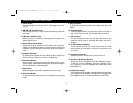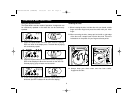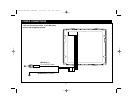
11
SAFETY INSTRUCTIONS
Read Instructions: All the safety and operating instructions
should be read before the appliance is operated.
Retain Instructions: The safety and operating instructions
should be retained for future reference.
Heed Warnings: All warnings on the appliance and in the oper-
ating instructions should be adhered to.
Follow Instructions: All operating and use instructions should
be followed.
Water and Moisture: The appliance should not be used near
water-- for example, near a bathtub, washbowl, kitchen sink,
laundry tub, in a wet basement, or near a swimming pool, etc.
Wall or Ceiling Mounting: The appliance should be mounted to
a wall or ceiling only recommended by the manufacturer.
Heat: The appliance should be situated away from heat sources
such as radiators, heat registers, stoves, or other appliances
(including amplifiers) that produce heat.
Power Supply: The appliance should be connected to a power
supply only of the type described in the operating instructions or
as marked on the appliance.
Cleaning: The appliance should be cleaned only as recom-
mended by the manufacturer.
Power Lines: An outdoor antenna should be located away from
power lines.
Antenna Lead-In Wire (B)
Antenna Discharge
Unit (C)
To Receiver
Mast
Ground
Clamp
Ground
Wire
(A,B)
Grounding
Clamps
Grounding Electrode
Drivin 8' Into the Earth
2.44 Meters
Figure 1.
Example of Antenna Grounding as per
National Electrical Code. Instructions
Contained in Artical 810-"Radio and
Television Equipment"
A) Use No. 10 AWG (5.3mm2) copper, No 8 AWG (8.4mm2) aluminum, No. 17
AWG (1.0mm2) copper clad steel or bronze wire, or larger, as ground wire.
B) Secure antenna lead-in and ground wires to house with stand-off insulators
spaced from 4 feet (1.22m) to 6 feet (1.83m) apart.
C) Mount antenna discharge unit as close as possible to where lead-in enters
house.
Outdoor Antenna Grounding: If an outside antenna is con-
nected to the receiver, be sure the antenna system is grounded
so as to provide some protection against voltage surges and built
up static charges. Section 810 of the National Electrical Code,
ANSI/NFPS no. 70-1983, provides information with respect to
proper grounding of the mast and supporting structure, ground-
ing of the lead-in wire to an antenna discharge unit, size of
grounding conductors, location of antenna-discharge unit, con-
nection to grounding electrodes, and requirements for the
grounding electrode. See figure 1.
Object and Liquid Entry: Care should be taken so that objects
do not fall and liquids are not spilled into the enclosure through
openings.
LS7600CDCDSGINS (SAMSUNG) 08/03/00 3:07 PM Page 11














